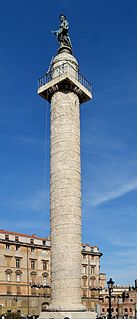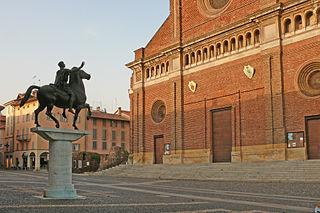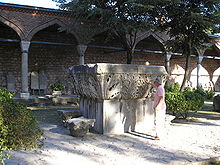
Marcian was Roman emperor of the East from 450 to 457. Very little of his life before becoming emperor is known, other than that he was a domesticus who served under the commanders Ardabur and his son Aspar for fifteen years. After the death of Emperor Theodosius II on 28 July 450, Marcian was made a candidate for the throne by Aspar, who held much influence because of his military power. After a month of negotiations Pulcheria, Theodosius' sister, agreed to marry Marcian. Zeno, a military leader whose influence was similar to Aspar's, may have been involved in these negotiations, as he was given the high-ranking court title of patrician upon Marcian's accession. Marcian was elected and inaugurated on 25 August 450.

Leo I, also known as "the Thracian", was Eastern Roman emperor from 457 to 474. He was a native of Dacia Aureliana near historic Thrace. He is sometimes surnamed with the epithet "the Great", probably to distinguish him from his young grandson and co-augustus Leo II.

Flavius Zeno was Eastern Roman emperor from 474 to 475 and again from 476 to 491. Domestic revolts and religious dissension plagued his reign, which nevertheless succeeded to some extent in foreign issues. His reign saw the end of the Western Roman Empire following the deposition of Romulus Augustus and the death of Julius Nepos, but he was credited with contributing much to stabilising the Eastern Empire.

Flavius Basiliscus was Eastern Roman emperor from 9 January 475 to August 476. He became magister militum per Thracias in 464, under his brother-in-law, Emperor Leo. Basiliscus commanded the army for an invasion of the Vandal Kingdom in 468, which was defeated at the Battle of Cape Bon. There were accusations at the time that Basiliscus was bribed by Aspar, the magister militum; many historians dismiss this, instead concluding that Basiliscus was either incompetent or foolish for accepting Vandal King Gaiseric's offer of a truce, which the latter used to construct fireships. Basiliscus's defeat cost the Eastern Empire 130,000 pounds (59,000 kg) of gold, causing the empire to hover above bankruptcy for 30 years. When Basiliscus returned to Constantinople, he sought refuge in the Church of St. Sophia. His sister, Empress Verina, secured him a pardon and he left the church to retire in Neapolis.

Trajan's Column is a Roman triumphal column in Rome, Italy, that commemorates Roman emperor Trajan's victory in the Dacian Wars. It was probably constructed under the supervision of the architect Apollodorus of Damascus at the order of the Roman Senate. It is located in Trajan's Forum, north of the Roman Forum. Completed in AD 113, the freestanding column is most famous for its spiral bas relief, which depicts the wars between the Romans and Dacians. Its design has inspired numerous victory columns, both ancient and modern.

Aelia Pulcheria was an Eastern Roman empress who advised her brother emperor Theodosius II during his minority and then became wife to emperor Marcian from November 450 to her death in 453.

Aelia Verina was the Empress consort of Leo I of the Eastern Roman Empire. She was a sister of Basiliscus. Her daughter Ariadne was Empress consort of first Zeno and then Anastasius I. Verina was the maternal grandmother of Leo II.

Sultanahmet Square, or the Hippodrome of Constantinople is a square in Istanbul, Turkey. Previously, it was a circus that was the sporting and social centre of Constantinople, capital of the Byzantine Empire.

A victory column, or monumental column or triumphal column, is a monument in the form of a column, erected in memory of a victorious battle, war, or revolution. The column typically stands on a base and is crowned with a victory symbol, such as a statue. The statue may represent the goddess Victoria; in Germany, the female embodiment of the nation, Germania; in the United States either female embodiment of the nation Liberty or Columbia; in the United Kingdom, the female embodiment Britannia, an eagle, or a war hero.

The Colossus of Barletta is a large bronze statue of a Roman emperor, nearly three times life size in Barletta, Italy.

The Arch of Septimius Severus at the northeastern end of the Roman Forum is a white marble triumphal arch dedicated in 203 A.D. to commemorate the Parthian victories of Emperor Septimius Severus and his two sons, Caracalla and Geta, in the two campaigns against the Parthians of 194-195 A.D. and 197–199 A.D. After the death of Septimius Severus, his sons Caracalla and Geta were initially joint emperors. Caracalla had Geta assassinated in 212 A.D.; Geta's memorials were destroyed and all images or mentions of him were removed from public buildings and monuments. Accordingly, Geta's image and inscriptions referring to him were removed from the arch.

The Basilica Cistern, or Cisterna Basilica, is the largest of several hundred ancient cisterns that lie beneath the city of Istanbul, Turkey. The cistern, located 150 metres (490 ft) southwest of the Hagia Sophia on the historical peninsula of Sarayburnu, was built in the 6th century during the reign of Byzantine Emperor Justinian I. Today it is kept with little water, for public access inside the space.

The Theodosian dynasty was a Roman imperial family that produced five Roman emperors during Late Antiquity, reigning over the Roman Empire from 379 to 457. The dynasty's patriarch was Theodosius the Elder, whose son Theodosius the Great was made Roman emperor in 379. Theodosius's two sons both became emperors, while his daughter married Constantius III, producing a daughter that became an empress and a son also became emperor. The dynasty of Theodosius married into, and reigned concurrently with, the ruling Valentinianic dynasty, and was succeeded by the Leonid dynasty with the accession of Leo the Great.

The Column of Constantine is a Roman monumental column built for Roman emperor Constantine the Great to commemorate the dedication of Constantinople on 11 May 330 AD. Built c. 328 AD, it is the oldest Constantinian monument in Istanbul and stood in the centre of the Forum of Constantine. It occupies the second-highest hill of the seven hills of Constantine's Nova Roma, the erstwhile Byzantium, and was midway along the Mese odos, the ancient city's main thoroughfare.

The AqueductofValens was a Roman aqueduct system built in the late 4th century AD, to supply Constantinople – the capital of the eastern Roman empire. Construction of the aqueduct began during the reign of the Roman emperor Constantius II and was completed in 373 by the emperor Valens. The aqueduct remained in use for many centuries. It was extended and maintained by the Byzantines and the Ottomans.
The Palace of Antiochos was an early 5th-century palace in the Byzantine capital, Constantinople. It has been identified with a palatial structure excavated in the 1940s and 1950s close to the Hippodrome of Constantinople, some of whose remains are still visible today. In the 7th century, a part of the palace was converted into the church–more properly a martyrion, a martyr's shrine–of St Euphemia in the Hippodrome, which survived until the Palaiologan period.
The column of Arcadius was a Roman triumphal column in the forum of Arcadius in Constantinople built in the early 5th century AD. The marble column was historiated with a spiralling frieze of reliefs on its shaft and supported a colossal statue of the emperor, probably made of bronze, which fell down in 740. Its summit was accessible by an internal spiral staircase. Only its massive masonry base survives.

The Regisole was a bronze classical or Late Antique equestrian monument, highly influential during the Italian Renaissance but destroyed in 1796. It was originally erected at Ravenna, in what is now Italy, but was moved to Pavia in the Middle Ages, where it stood on a column before the cathedral, as an emblem of communal pride and Pavia's deep connection with imperial Rome.

The Battle of Cape Bon was an engagement during a joint military expedition of the Western and Eastern Roman Empires led by Basiliscus against the Vandal capital of Carthage in 468. The invasion of the kingdom of the Vandals was one of the largest amphibious operations in antiquity, with 1,113 ships and over 50,000 personnel.
























